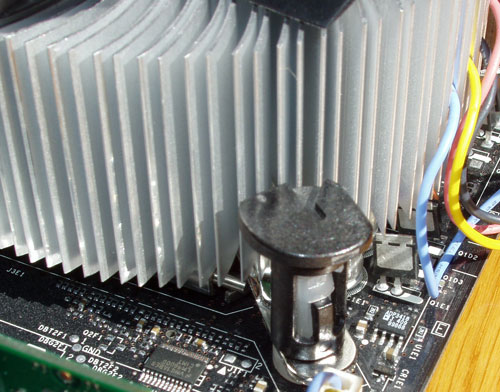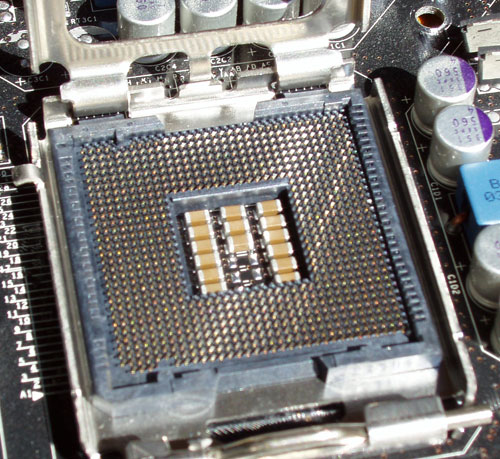Intel's Pentium 4 570J - Will 3.8GHz do the trick?
by Anand Lal Shimpi on November 14, 2004 10:56 AM EST- Posted in
- CPUs
An update on LGA-775
When Intel first launched the LGA-775 socket we were skeptical; reports of extremely high failure rates of initial sockets were pouring out of Taiwan and we had feared the worst: had Intel finally broken all ties with the enthusiast community by implementing a socket that would fail after a couple of insertions?
Now, 5 months after the public introduction of LGA-775, we can say that our deepest fears didn’t end up materializing. We’ve done a tremendous number of LGA-775 CPU installations over the past several months across various motherboards and have yet to encounter a system that will no longer POST or even a single bent pin on the motherboard.
We do have complaints about Intel’s retail heatsink/fan and its mounting mechanism. While we were originally quite impressed with how much easier the LGA-775 HSF mounted than the older Socket-478 units, the more we used them, the more we began to despise them just as much as we did the previous model.

The problem with the new heatsink is that it is very easy to not get all of the four pegs to lock into place properly, which usually results in a clock throttling CPU that’s difficult to detect. The issue seems to be much more common on the higher speed Prescotts (3.6GHz and 3.8GHz); the first time you mount the heatsink it’s usually not a problem, but remove it and reinstall it a few times and now things aren’t quite as perfect. The pegs don’t always lock into place securely and we’ve had cases where one of the pegs will pop out of place. Usually if you spend more time with it and apply a good amount of pressure to the culprit pegs you’ll avoid any issues. It’s not an unsurmountable problem but it’s definitely an annoyance we’ve had since the launch of the LGA-775 socket.
We much prefer AMD’s simple, single lever approach to heatsink installation as it is effortless and we’ve never had an issue with an improperly cooled CPU. To Intel’s credit, the Pentium 4 does produce significantly more heat than the Athlon 64 so maintaining better contact between the heatsink and the CPU is much more important to Intel than AMD, but that doesn’t change the fact that Intel’s heatsink can be a pain to install and reinstall.
The worries of users bending pins in the socket and returning their motherboards also doesn’t seem to be a real issue as we haven’t heard any complaints from the Taiwanese motherboard manufacturers.











42 Comments
View All Comments
pplapeu - Wednesday, November 17, 2004 - link
why do you no longer overclock?you know users will do that. What if this processor was dialed up 10%, it would clock at 4.18Ghz and could run faster. I think the performance tales would be far different.
Staples - Monday, November 15, 2004 - link
Well the CEO did step down a few days ago. I hope we see better management soon. This is an embarrasment for Intel. Ever since the A64 came out, Intel has been releasing backseat products.IntelUser2000 - Monday, November 15, 2004 - link
No, its that most of you guys are AMD biased. Say Intel does release a high-performing Pentium M architecture based chip. Then you guys will just shut up and say nothing else. If AMD comes with 5% performance lead, AMD is thought of as GOD or something. Probably even greater. And about BTX, Pentium M does run pretty cool, but at 21W, that was equal to initial 0.18 micron P3's. Actually some of the DESKTOP P3's had ~15W TDP. I heard 286's and 386's had less than 5W TDP. Cooler, and faster is always better. Granted you may not need as much if your processor runs hotter, but still its necessary. It's also mentioned that since quiet PCs are gaining popularity, BTX can help a lot since it will allow graphics cards to have smaller fans.Another 3.8GHz P4 link: http://www.tomshardware.com/cpu/20041115/index.htm...
Quite contrary to their 3.6GHz throttling article, they seem positive towards 3.8GHz P4.
fawifewaewaf - Sunday, November 10, 2013 - link
diaff cretinmlittl3 - Monday, November 15, 2004 - link
#35,Do you know that the long post of #21 is the author of the article you just read (which is way longer than any post) and the owner of Anandtech? Do you see the post is from ANAND Lal Shimpi? And that his post was in response to the other long post which Anand saw as important enough to respond to.
I enjoy all the comments on this site, long and short. It gives readers a sort of "behind the scenes" look at hardware and software. I think there should be no restrictions as it currently stands.
Keep 'em coming. Go Anandtech :)
bob661 - Monday, November 15, 2004 - link
Based on #32's link, it would seem that the P4's would decrease in performance during sustained use with an average user. So unless you're an enthusiast, you would not see the full performance of any of the new P4's.Alphafox78 - Monday, November 15, 2004 - link
There should be a size limit on posts...GTMan - Monday, November 15, 2004 - link
Does the EDB functionality lower system performance when it is turned on?Auteur - Monday, November 15, 2004 - link
#12:The only reason HardOCP uses DVD2AVI in their bench marking suite is its the only Divx front end that runs faster on AMD cpu's than Intel's. Its a dead app (the author no longer updates it) that can't IVTC, deinterlace, clean or sharpen video. Its great for demuxing audio and thats it.
Intel's chips dominate when you use the popular front ends like AutoGK, Gordian Knot or Xmpeg. Read Doom9's forum if you don't believe me.
langles - Monday, November 15, 2004 - link
Did you read the article at Tom's Hardware this weekend about the thermal issues with the Pentium 4 3.6 GHz?http://www.tomshardware.com/cpu/20041114/index.htm...
"The Heat Can Cause Intel's P4 To Throttle And Damage Over Time"
I would expect that this issue is even worse for the 3.8 GHz.